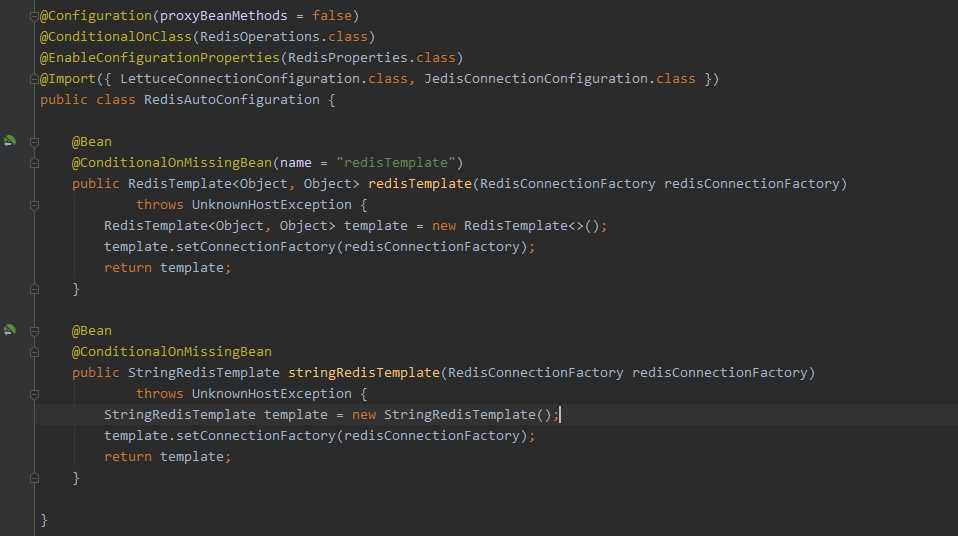前面我们已经介绍过【SpringBoot】十七、SpringBoot 中整合 Redis,我们可以看出,在 SpringBoot 对 Redis 做了一系列的自动装配,使用还是非常方便的
一、背景
- 1、思考
通过我们前面的学习,我们已经可以往 Redis 中存入字符串,那么我们要往 Redis 中存入 Java 对象该怎么办呢? - 2、方案
我们可以将 Java 对象转化为 JSON 对象,然后转为 JSON 字符串,存入 Redis,那么我们从 Redis 中取出该数据的时候,我们也只能取出字符串,并转为 Java 对象,这一系列的操作是不是显得有些麻烦呢?
二、源码分析
- 以上是 RedisAutoConfiguration 类中的源码片段,可以看出 SpringBoot 对 Redis 做自动化配置的时候,在容器中注入了 redisTemplate 和 stringRedisTemplate
- 其中,RedisTemplate<Object, Object> 表示,key 的类型为 Object,value 的类型为 Object,但是我们往往需要的是 RedisTemplate<String, Object>,这就需要我们重新注入一个 RedisTemplate 的 Bean,它的泛型为 RedisTemplate<String, Object>,并设置 key,value 的序列化方式
- 看到这个@ConditionalOnMissingBean注解后,就知道如果Spring容器中有了RedisTemplate对象了,这个自动配置的RedisTemplate不会实例化。因此我们可以直接自己写个配置类,配置RedisTemplate。
三、注入RedisTemplate
- 1、引入依赖
<!-- redis -->
<dependency>
<groupId>org.springframework.boot</groupId>
<artifactId>spring-boot-starter-data-redis</artifactId>
</dependency>
以上引入了 redis 的依赖,其余依赖请自行添加
- 2、Redis 连接信息
spring:
# Redis配置
redis:
host: 127.0.0.1
port: 6379
database: 10
jedis:
pool:
# 连接池最大连接数(使用负值表示没有限制)
max-active: 50
# 连接池最大阻塞等待时间(使用负值表示没有限制)
max-wait: 3000ms
# 连接池中的最大空闲连接数
max-idle: 20
# 连接池中的最小空闲连接数
min-idle: 5
# 连接超时时间(毫秒)
timeout: 5000ms
- 3、Redis 核心配置类
Redis 的核心配置我们放在 RedisConfig.java 文件中
package com.zyxx.redistest.common;
import com.fasterxml.jackson.annotation.JsonAutoDetect;
import com.fasterxml.jackson.annotation.PropertyAccessor;
import com.fasterxml.jackson.databind.ObjectMapper;
import org.springframework.context.annotation.Bean;
import org.springframework.context.annotation.Configuration;
import org.springframework.data.redis.core.RedisTemplate;
import org.springframework.data.redis.serializer.Jackson2JsonRedisSerializer;
import org.springframework.data.redis.serializer.RedisSerializer;
import org.springframework.data.redis.serializer.StringRedisSerializer;
/** * @ClassName RedisConfig * @Description * @Author Lizhou * @Date 2020-10-22 9:48:48 **/
@Configuration
public class RedisConfig {
/** * RedisTemplate配置 */
@Bean
public RedisTemplate<Object, Object> redisTemplate(RedisConnectionFactory redisConnectionFactory) {
// 配置redisTemplate
RedisTemplate<Object, Object> redisTemplate = new RedisTemplate<>();
redisTemplate.setConnectionFactory(redisConnectionFactory);
// 设置序列化
Jackson2JsonRedisSerializer<Object> jackson2JsonRedisSerializer = new Jackson2JsonRedisSerializer<>(Object.class);
ObjectMapper om = new ObjectMapper();
om.setVisibility(PropertyAccessor.ALL, JsonAutoDetect.Visibility.ANY);
om.activateDefaultTyping(LaissezFaireSubTypeValidator.instance, ObjectMapper.DefaultTyping.NON_FINAL, JsonTypeInfo.As.PROPERTY);
jackson2JsonRedisSerializer.setObjectMapper(om);
// key序列化
redisTemplate.setKeySerializer(new StringRedisSerializer());
// value序列化
redisTemplate.setValueSerializer(jackson2JsonRedisSerializer);
// Hash key序列化
redisTemplate.setHashKeySerializer(new StringRedisSerializer());
// Hash value序列化
redisTemplate.setHashValueSerializer(jackson2JsonRedisSerializer);
redisTemplate.afterPropertiesSet();
return redisTemplate;
}
}
我们注入了一个名称为 redisTemplate,类型为 RedisTemplate<String, Object> 的 Bean,key 采用 StringRedisSerializer 序列化方式,value 采用 Jackson2JsonRedisSerializer 序列化方式
- 4、Redis工具类
我们将对 Redis 进行的一系列操作放在 RedisUtils.java 文件中
package com.zyxx.redistest.common;
import lombok.extern.slf4j.Slf4j;
import org.apache.commons.lang3.StringUtils;
import org.springframework.beans.factory.annotation.Autowired;
import org.springframework.data.redis.core.RedisTemplate;
import org.springframework.stereotype.Component;
/** * @ClassName RedisUtils * @Description * @Author Lizhou * @Date 2020-10-22 10:10:10 **/
@Slf4j
@Component
public class RedisUtils {
@Autowired
private RedisTemplate<String, Object> redisTemplate;
/** * 根据key读取数据 */
public Object get(final String key) {
if (StringUtils.isBlank(key)) {
return null;
}
try {
return redisTemplate.opsForValue().get(key);
} catch (Exception e) {
e.printStackTrace();
}
return null;
}
/** * 写入数据 */
public boolean set(final String key, Object value) {
if (StringUtils.isBlank(key)) {
return false;
}
try {
redisTemplate.opsForValue().set(key, value);
log.info("存入redis成功,key:{},value:{}", key, value);
return true;
} catch (Exception e) {
log.error("存入redis失败,key:{},value:{}", key, value);
e.printStackTrace();
}
return false;
}
}
我们写入了 get,set 两个方法用于测试
四、测试
- 1、创建 Java 实体类 UserInfo
package com.zyxx.redistest.common;
import lombok.Data;
import java.io.Serializable;
import java.util.Date;
/** * @ClassName UserInfo * @Description * @Author Lizhou * @Date 2020-10-22 10:12:12 **/
@Data
public class UserInfo implements Serializable {
/** * id */
private Integer id;
/** * 姓名 */
private String name;
/** * 创建时间 */
private Date createTime;
}
- 2、测试用例
package com.zyxx.redistest;
import com.zyxx.redistest.common.RedisUtils;
import com.zyxx.redistest.common.UserInfo;
import org.junit.jupiter.api.Test;
import org.springframework.beans.factory.annotation.Autowired;
import org.springframework.boot.test.context.SpringBootTest;
import java.util.Date;
@SpringBootTest
class RedisTestApplicationTests {
@Autowired
private RedisUtils redisUtil;
@Test
void contextLoads() {
UserInfo userInfo = new UserInfo();
userInfo.setId(1);
userInfo.setName("jack");
userInfo.setCreateTime(new Date());
// 放入redis
redisUtil.set("user", userInfo);
// 从redis中获取
System.out.println("获取到数据:" + redisUtil.get("user"));
}
}
我们向 Redis 中存入了一个 key 为 ”user“,value 为 UserInfo 对象的数据,然后再根据 key 获取该数据
- 3、测试结果
可以看出,我们往 Redis 中成功存入 Java 对象数据,并成功获取到了该对象
如您在阅读中发现不足,欢迎留言!!!
今天的文章【SpringBoot】34、SpringBoot整合Redis实现序列化存储Java对象分享到此就结束了,感谢您的阅读,如果确实帮到您,您可以动动手指转发给其他人。
版权声明:本文内容由互联网用户自发贡献,该文观点仅代表作者本人。本站仅提供信息存储空间服务,不拥有所有权,不承担相关法律责任。如发现本站有涉嫌侵权/违法违规的内容, 请发送邮件至 举报,一经查实,本站将立刻删除。
如需转载请保留出处:https://bianchenghao.cn/33550.html


